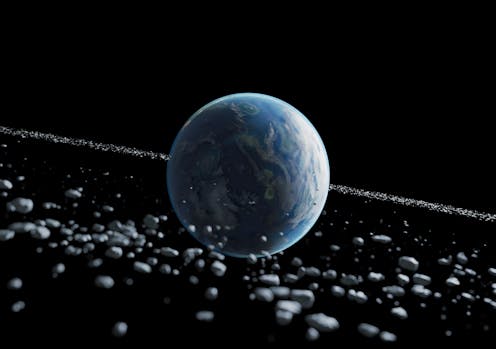Hidden craters reveal Earth may once have had a ring – like Saturn
- Written by The Conversation

The rings of Saturn are some of the most famous and spectacular objects in the Solar System. Earth may once have had something similar.
In a paper published last week in Earth & Planetary Science Letters, my colleagues and I present evidence that Earth may have had a ring.
The existence of such a ring, forming around 466 million years ago and persisting for a few tens of millions of years, could explain several puzzles in our planet’s past.
The case for a ringed Earth
Around 466 million years ago, a lot of meteorites started hitting Earth. We know this because many impact craters formed in a geologically brief period.
In the same period we also find deposits of limestone across Europe, Russia and China containing very high levels of debris from a certain type of meteorite. The meteorite debris in these sedimentary rocks show signs that they were exposed to space radiation for much less time than we see in meteorites that fall today.
Many tsunamis also occurred at this time, as can be seen from other unusual jumbled up sedimentary rocks.
We think all these features are likely related to one another. But what links them together?
A pattern of craters
We know of 21 meteorite impact craters that formed during this high-impact period. We wanted to see if there was a pattern in their locations.
Using models of how Earth’s tectonic plates moved in the past, we mapped out where all these craters were when they first formed. We found all of the craters are on continents that were close to the equator in this period, and none are in places that were closer to the poles.
So all the impacts occurred close to the equator. But is this actually a fair sample of the impacts that occurred?
Well, we measured how much of Earth’s land surface suitable for preserving a crater was near the equator at that time. Only about 30% of the suitable land was close to the equator, with 70% at higher latitudes.
Under normal circumstances, asteroids hitting Earth can hit at any latitude, at random, as we see in craters on the Moon, Mars and Mercury.
So it’s extremely unlikely that all 21 craters from this period would form close to the equator if they were unrelated to one another. We would expect to see many other craters at higher latitudes as well.
We think the best explanation for all this evidence is that a large asteroid broke up during a close encounter with Earth. Over several tens of millions of years, the asteroid’s debris rained down onto Earth, creating the pattern of craters, sediments and tsunamis we describe above.
How rings form
You may know that Saturn isn’t the only planet with rings. Jupiter, Neptune and Uranus have less obvious rings, too. Some scientists have even suggested that Phobos and Deimos, the small moons of Mars, may be remnants of an ancient ring.
So we know a lot about how rings form. Here’s how it works.
When a small body (like an asteroid) passes close to a large body (like a planet), it gets stretched by gravity. If it gets close enough (inside a distance called the Roche limit), the small body will break apart into lots of tiny pieces and a small number of bigger pieces.
All those fragments will be jostled around and gradually evolved into a debris ring orbiting the equator of the larger body. Over time, the material in the ring will fall down to the larger body, where the larger pieces will form impact craters. These craters will be located close to the equator.
So if Earth destroyed and captured a passing asteroid around 466 million years ago, it would explain the anomalous locations of the impact craters, the meteorite debris in sedimentary rocks, craters and tsunamis, and the meteorites’ relatively brief exposure to space radiation.
A giant sunshade?
Back then, the continents were in different positions due to continental drift. Much of North America, Europe and Australia were close to the equator, whereas Africa and South America were at higher southern latitudes.
The ring would have been around the equator. And since Earth’s axis is tilted relative to its orbit around the Sun, the ring would have shaded parts of Earth’s surface.
This shading in turn might have caused global cooling, as less sunlight reached the planet’s surface.
This brings us to another interesting puzzle. Around 465 million years ago, our planet began cooling dramatically. By 445 million years ago it was in the Hirnantian Ice Age, the coldest period in the past half a billion years.
Was a ring shading Earth responsible for this extreme cooling? The next step in our scientific sleuthing is to make mathematical models of how asteroids break up and disperse, and how the resulting ring evolves over time. This will set the scene for climate modelling that explores how much cooling could be imposed by such a ring.
Read more https://theconversation.com/hidden-craters-reveal-earth-may-once-have-had-a-ring-like-saturn-239068







